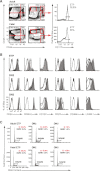Global transcriptional analysis of primitive thymocytes reveals accelerated dynamics of T cell specification in fetal stages
- PMID: 22581009
- PMCID: PMC3395349
- DOI: 10.1007/s00251-012-0620-6
Global transcriptional analysis of primitive thymocytes reveals accelerated dynamics of T cell specification in fetal stages
Abstract
T cell development constitutes a multistage process allowing the dissection of events resulting in cellular commitment and functional specification in a specialized microenvironment. This process is guided by the appropriate expression of regulatory genetic factors like transcriptional activators or repressors which are, in part, dependent on instructive signals of the microenvironment. To date, it remains unclear whether exactly the same genetic mechanism acts in adult compared to fetal T cell development. In order to directly compare T cell commitment during adult and fetal differentiation, we isolated subsequent stages of intrathymic subpopulations starting with early canonical T cell progenitors up to irreversibly committed T cell precursors. The genome-wide analysis revealed several distinct gene clusters with a specific pattern of gene regulation for each subset. The largest cluster contained genes upregulated after transition through the most primitive pool into the next transitory population with a consistently elevated expression of elements associated with ongoing T cell fate specification, like Gata3 and Tcf7, in fetal progenitors. Furthermore, adult and fetal T cell progenitors occupied distinct "transcriptional territories" revealing a precise land map of the progression to final T cell commitment operating in different developmental windows. The presence and/or elevated expression of elements associated with an ongoing establishment of a T cell signature in the most primitive fetal subset is highly suggestive for an extrathymic initiation of T cell specification and underlines the fundamental differences in fetal versus adult lymphopoiesis.
Figures




References
MeSH terms
Grants and funding
LinkOut - more resources
Full Text Sources
Other Literature Sources
Molecular Biology Databases

